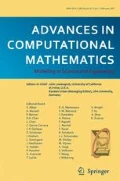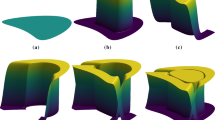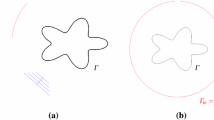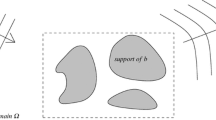Abstract
An efficient direct solver for solving the Lippmann–Schwinger integral equation modeling acoustic scattering in the plane is presented. For a problem with N degrees of freedom, the solver constructs an approximate inverse in \(\mathcal {O}(N^{3/2})\) operations and then, given an incident field, can compute the scattered field in \(\mathcal {O}(N \log N)\) operations. The solver is based on a previously published direct solver for integral equations that relies on rank-deficiencies in the off-diagonal blocks; specifically, the so-called Hierarchically Block Separable format is used. The particular solver described here has been reformulated in a way that improves numerical stability and robustness, and exploits the particular structure of the kernel in the Lippmann–Schwinger equation to accelerate the computation of an approximate inverse. The solver is coupled with a Nyström discretization on a regular square grid, using a quadrature method developed by Ran Duan and Vladimir Rokhlin that attains high-order accuracy despite the singularity in the kernel of the integral equation. A particularly efficient solver is obtained when the direct solver is run at four digits of accuracy, and is used as a preconditioner to GMRES, with each forwards application of the integral operators accelerated by the FFT. Extensive numerical experiments are presented that illustrate the high performance of the method in challenging environments. Using the 10th-order accurate version of the Duan–Rokhlin quadrature rule, the scheme is capable of solving problems on domains that are over 500 wavelengths wide to relative error below 10− 10 in a couple of hours on a workstation, using 26M degrees of freedom.
Similar content being viewed by others
References
Ambikasaran, S, Borges, C, Imbert-Gerard, L-M, Greengard, L: Fast, adaptive, high-order accurate discretization of the Lippmann–Schwinger equation in two dimensions. SIAM J. Sci. Comput. 38(3), A1770–A1787 (2016)
Ambikasaran, S, Darve, E: An \(\mathcal {O}(n \log {N})\) fast direct solver for partial hierarchically semi-separable matrices. J. Sci. Comput. 57(3), 477–501 (2013)
Babuška, Ivo, Sauter, Stefan: Is the pollution effect of the FEM avoidable for the Helmholtz equation considering high wave numbers? SIAM J. Numer. Anal. 34(6), 2392–2423 (1997)
Berenger, J-P: A perfectly matched layer for the absorption of electromagnetic waves. J. Comput. Phys. 114(2), 185–200 (1994)
Borges, C, Gillman, A, Greengard, L: High resolution inverse scattering in two dimensions using recursive linearization. SIAM J. Imaging Sci. 10 (2), 641–664 (2017)
Börm, S: Efficient Numerical Methods for Non-local Operators: \({\mathscr{H}}^{2}\)-Matrix Compression, Algorithms and Analysis, vol. 14. European Mathematical Society (2010)
Bremer, J, Gillman, A, Martinsson, P-G: A high-order accurate accelerated direct solver for acoustic scattering from surfaces. BIT Numer. Math. 55(2), 367–397 (2015)
Chandrasekaran, S, Gu, M: A divide-and-conquer algorithm for the eigendecomposition of symmetric block-diagonal plus semiseparable matrices. Numer. Math. 96(4), 723–731 (2004)
Chen, Y: A fast direct algorithm for the Lippmann–Schwinger integral equation in two dimensions. Adv. Comput. Math. 16(2), 175–190 (2002)
Cheng, H, Gimbutas, Z, Martinsson, P-G, Rokhlin, V: On the compression of low rank matrices. SIAM J Sci Comput 26(4), 1389–1404 (2005)
Colton, D, Kress, R: Inverse acoustic and electromagnetic scattering theory, vol. 93, 4th edn. Springer Science & Business Media (2019)
Corona, E., Martinsson, P-G, Zorin, D: An \(\mathcal {O}(n)\) direct solver for integral equations on the plane. Appl. Comput. Harmon. Anal. 38(2), 284–317 (2015)
Duan, R, Rokhlin, V: High-order quadratures for the solution of scattering problems in two dimensions. J. Comput. Phys. 228(6), 2152–2174 (2009)
Engquist, B, Majda, A: Absorbing boundary conditions for numerical simulation of waves. Proc. Natl. Acad. Sci. 74(5), 1765–1766 (1977)
Gillman, A, Young, P, Martinsson, P-G: A direct solver with \(\mathcal {O}(n)\) complexity for integral equations on one-dimensional domains. Front. Math. China 7(2), 217–247 (2012)
Gillman, A, Barnett, A, Martinsson, P-G: A spectrally accurate direct solution technique for frequency-domain scattering problems with variable media. BIT Numer. Math. 55(1), 141–170 (2015)
Golub, GH, Van Loan, CF: Matrix computations (2013)
Greengard, L, Rokhlin, V: A fast algorithm for particle simulations. J. Comput. Phys. 73(2), 325–348 (1987)
Greengard, L, Rokhlin, V: On the numerical solution of two-point boundary value problems. Commun. Pure Appl. Math. 44(4), 419–452 (1991)
Gu, M, Eisenstat, S: Efficient algorithms for computing a strong rank-revealing QR factorization. SIAM J. Sci. Comput. 17(4), 848–869 (1996)
Hackbusch, W: A sparse matrix arithmetic based on \({\mathscr{H}}\)-matrices. Part I: Introduction to \({\mathscr{H}}\)-matrices. Computing 62(2), 89–108 (1999)
Ho, K, Greengard, L: A fast direct solver for structured linear systems by recursive skeletonization. SIAM J. Sci. Comput. 34(5), A2507–A2532 (2012)
Ho, K, Ying, L: Hierarchical interpolative factorization for elliptic operators Integral equations. Commun. Pure Appl. Math. 69, 1314–1353 (2016)
Martinsson, P-G: Fast direct solvers for elliptic PDEs, volume CB96 of CBMS-NSF Conference Series. SIAM (2019)
Martinsson, P-G, Rokhlin, V: A fast direct solver for boundary integral equations in two dimensions. J. Comput. Phys. 205(1), 1–23 (2005)
Michielssen, E, Boag, A, Chew, WC: Scattering from elongated objects: direct solution in \({O}({N}\log ^{2}{N})\) operations. IEE Proc. - Microw. Antennas Propag. 143(4), 277–283 (1996)
Minden, V, Ho, K, Damle, A, Ying, L: A recursive skeletonization factorization based on strong admissibility. Multiscale Model. Simul. 15 (2), 768–796 (2017)
Starr, P., Rokhlin, V.: On the numerical solution of two-point boundary value problems. II. Commun. Pure Appl. Math. 47(8), 1117–1159 (1994)
Woolfe, F., Liberty, E., Rokhlin, V., Tygert, M.: A fast randomized algorithm for the approximation of matrices. Appl. Comput. Harmon. Anal. 25(3), 335–366 (2008)
Xia, J., Chandrasekaran, S., Gu, M., Li, X.S.: Fast algorithms for hierarchically semiseparable matrices. Numer. Linear Algebra Appl. 17 (6), 953–976 (2010)
Acknowledgements
Vladimir Rokhlin has generously shared his insights about the problems under consideration, and we gratefully acknowledge his contributions. We thank Ran Duan for sharing codes to compute the quadrature weights, and Alex Barnett for sharing codes to compute the photonic crystal. We also thank the anonymous referees for their valuable advice and suggestions.
Funding
The work of PGM was funded by the Office of Naval Research (award N00014-18-1-2354), by the National Science Foundation (awards 1952735 and 1620472), and by Nvidia Corp.
Author information
Authors and Affiliations
Corresponding author
Ethics declarations
Conflict of interest
The authors declare no competing interests.
Additional information
Communicated by: Michael O’Neil
Publisher’s note
Springer Nature remains neutral with regard to jurisdictional claims in published maps and institutional affiliations.
This article belongs to the Topical Collection: Advances in Computational Integral Equations Guest Editors: Stephanie Chaillat, Adrianna Gillman, Per-Gunnar Martinsson, Michael O’Neil, Mary-Catherine Kropinski, Timo Betcke, Alex Barnett
Rights and permissions
About this article
Cite this article
Gopal, A., Martinsson, PG. An accelerated, high-order accurate direct solver for the Lippmann–Schwinger equation for acoustic scattering in the plane. Adv Comput Math 48, 42 (2022). https://doi.org/10.1007/s10444-022-09963-1
Received:
Accepted:
Published:
DOI: https://doi.org/10.1007/s10444-022-09963-1




